What Is Schema Markup for Healthcare & Why Is It Crucial for Modern SEO?
Schema markup is one of the levers that search engine optimization (SEO) specialists can leverage. Yet, it is surprisingly underutilized, making it an opportune way to increase your healthcare organization’s visibility on search engine results pages (SERPs).
According to SEMRush, 92% of the top 10 results in Google Search incorporate schema markup. Although correlation does not equal causation, Google has mentioned in their documentation the importance of the correct schema to help improve their search results.
But what exactly is schema markup? Schema markup is a form of structured data that, when added to a website, allows search engines to better read and understand the content on your web pages by breaking down structured information (like addresses, services, and names) into bite-sized chunks the search engine can understand, resulting in richer more engaging search results for relevant search queries, and the potential of increased click-through rates.
In fact, a recent Nestlé Research & Development study revealed that pages leveraging schema markup to encourage rich results pages had an astonishing 82% higher click-through rate than pages without rich results driven by their schema implementation.
Importance of Schema Markup for Healthcare SEO
Search engines use structured data to create more engaging search displays within the search results, increasing the visibility of your website pages and encouraging more page clicks and site engagement.
For healthcare websites, with many specialties, therapies, procedures, and conditions well-defined as schema options, the proper schema markup can be the difference between winning clicks or losing out to a competitor.
But where do you start?
Schema Markup 101
Search engines have massive amounts of data to consume and organize. Imagine arriving at a library only to find the books scattered on the floor without order or cataloging. In many ways, the growth of the Internet has presented the same challenge to search engines. It houses a mass of websites that are all very different and contain billions of pages of content, varying as much as the look and feel of websites.
To help (at least in a small way) search engines understand what a page is, as well as what a page is about, the major search engines (Google, Microsoft, Yahoo, and Yandex) decided to create some well-defined hierarchical structures that are consistent across the web and allow search engines to recognize some structure in pages uniformly. (Rather like putting books on relevant shelves with their titles facing outwards.)
At the very top level, objects are defined very much like the “animal,” “vegetable,” or “mineral,” with “Thing”—the most generic of items—at the very top.
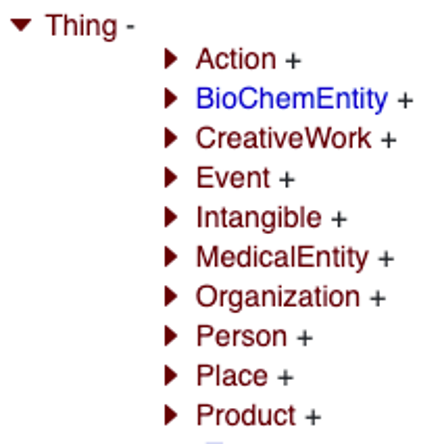
These then have distinct subcategories that get deeper into a thing’s meaning:
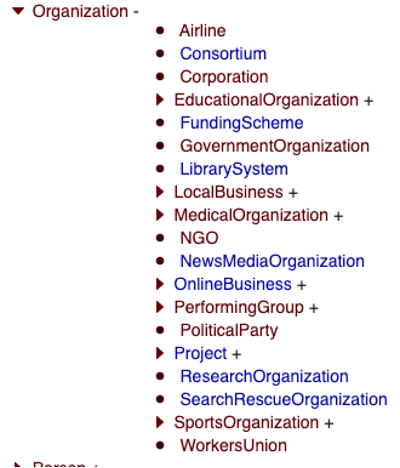
The schema database is available at https://www.schema.org and contains categories, subcategories, and organizational references for a broad range of topics and subjects, ranging from “people” to “products” to “medical procedures” to—yes—“books.”
Using a book example: Once you define that a web page is about a book, you can then logically add the attributes of that book: author, publishing date, cover, and other information relevant to that book.
By adding schema to the page code and telling search engines what each snippet of information is related to, they can better understand and present the information in search results.
Example: This search result about Merck Manuals notes the published date, author, and book cover. All these elements can be defined in the schema for a more interesting display in search results.
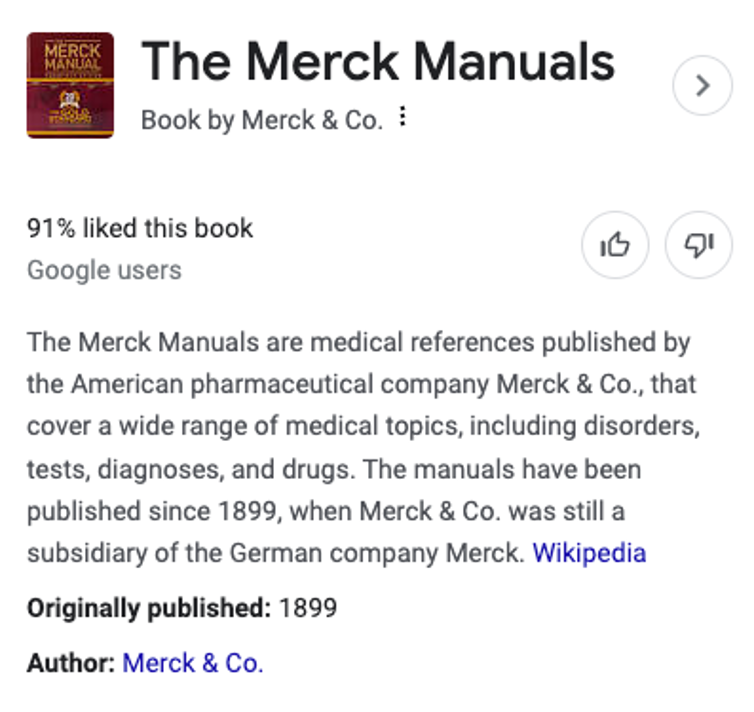
It’s these kinds of attributes that help clarify and differentiate one medical organization or specialty from another. Schema markup for healthcare allows search engines to easily understand your products, services, and medical specialties, helping your search results be more informative, engaging, and attractive.
Healthcare organizations can leverage schema markup to highlight things users often search for (e.g., contact information, medical specialties, accepted insurances, business hours, location, patient testimonials, and more) directly on the SERP.
Think of schema markup as helping search engines build a “virtual business card” for your organization, facilitating a seamless—and visually engaging—connection between healthcare consumers and your services.
Types of Schema Markup for Healthcare
Here is a list of schema markup commonly used by hospitals and health systems and their common applications:
- HealthcareService
A single healthcare service or category of services provided by a healthcare organization. - HealthInsurancePlan
A US-style healthcare insurance plan (e.g., PPO, EPO, and HMO). - Hospital
A hospital name. - MedicalBusiness
A particular physical or virtual business of a medical organization. - MedicalCondition
Any physical or mental condition that affects normal functioning. - MedicalOrganization
A physical or virtual medical organization (e.g., hospital, institution, or clinic). - MedicalProcedure
A process of care used in either diagnostic, therapeutic, preventive, or palliative capacity that relies on invasive (surgical), non-invasive, or other techniques. - MedicalSpecialty
Any specific branch of medical science or practice, including clinical specialties about organ systems and their respective diseases and allied health specialties. This markup is often enumerated with specific specialties (e.g., anesthesia, cardiovascular, dentistry). - MedicalTherapy
Any curative or palliative medical interventions or processes of care designed to prevent, treat, or cure human diseases and medical conditions (e.g., pharmacotherapy, behavioral therapy, supportive therapy, detoxification, etc.) - Physician
An individual physician or a physician’s office considered as a “MedicalOrganization.”
An important thing to note about physician schema and medical procedure schema markup for healthcare websites is that they are often used in conjunction with (and enhanced by) generic markups like “openingHours,” “Place,” “telephone,” “review,” “Rating,” and more.
Schema is a nestable ontology, meaning there are parent-child relationships in how one should think about both the structure and contents of schema code.
Note the different hierarchies of a hospital ‘thing’.

Next, we share how to use resources like Schema.org to research relevant medical vocabulary, tag your healthcare content appropriately, and integrate schema markup into your website.
Implementing Schema.org Vocabulary for Medical Entities
Step-by-Step Guide to Tagging Healthcare Content
| Warning: This next step is for tech-savvy individuals only. It requires adjusting the code on your website. Do you have a developer you can trust? If not, save this step for later or consider engaging with a skilled healthcare marketing agency for the support you need. |
To implement schema markup, you must identify relevant vocabulary, write the schema code, and add it to relevant pages on your organization’s site.
There are a few ways to implement schema markup for healthcare, but Google recommends using JSON-LD (JavaScript Object Notation for Linked Data), a lightweight linked data format.
Some JSON-LD can be added manually or through a plugin like SchemaPro, Rank Math, Header Footer Code Manager, or Yoast. To add the markup manually, start with a basic template and add details about your organization into each relevant field.
We have included a sample code that a page about Mad Cow’s Disease might use below. This is for illustrative purposes only.
<script type="application/ld+json" class="schemantra.com">{
"@context": "https://schema.org",
"@type": "MedicalCondition",
"@id": "Mad Cow Disease",
"alternateName": "Creutzfeldt-Jakob disease",
"description": "Creutzfeldt-Jakob disease (CJD) is a rapidly progressive, invariably fatal neurodegenerative disorder believed to be caused by an abnormal isoform of a cellular glycoprotein known as the prion protein.",
"disambiguatingDescription": "Classic CJD is not related to mad cow disease. Classic CJD also is distinct from variant CJD, another prion disease that is related to BSE.",
"expectedPrognosis": "May moo randomly",
"sameAs": "https://en.wikipedia.org/wiki/Bovine_spongiform_encephalopathy"
}
</script>
If you or your organization is new to medical structured data and schema markup, Schemantra.com offers an easy-to-use free generator to help you get started.
However, working with an experienced developer or expert healthcare marketing partner to create and implement schema markup for each of your web pages is highly recommended.
Here’s why.
Integrating Schema Markup with Existing Website Structure
Integrating basic (local business) schema markup on your healthcare website requires little technical know-how as Google offers a simple tool to automatically markup existing webpages with some basic (not medical) schema options:
- Go to Google’s Structured Data Markup Helper Tool.
- Select a data type (e.g., articles, products, etc.).
- Paste the URL of the page you want to add markup to.
- Click “Start Tagging.”
NOTE: Google’s Helper Tool does not have medical applications

- Begin adding desired markup by highlighting areas and assigning a markup.
- In the example below, I have highlighted the blog title and assigned it the markup “Name.”
- When finished, click “Create HTML.”
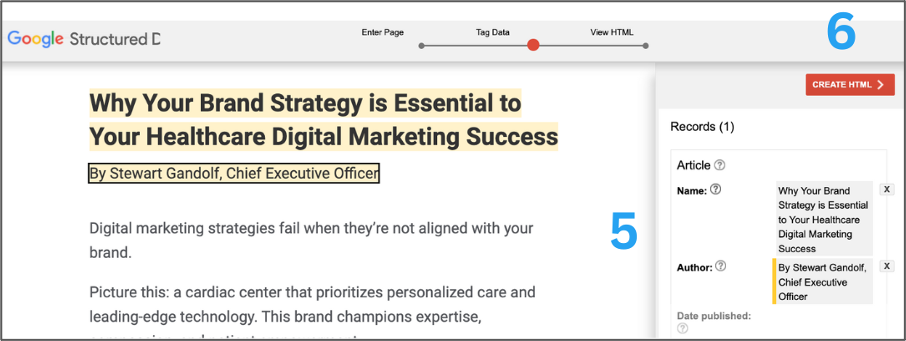
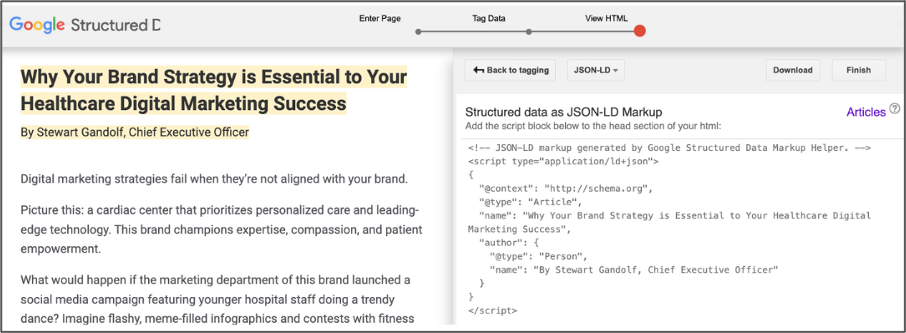
- Add the HTML schema markup to your web page.
- Test your schema markup using Google’s Rich Result Test.
- Fix errors if needed.
- Repeat as needed for other web pages.
Schema Markup for Healthcare Websites: Best Practices
When incorporating schema markup into your healthcare website, it’s crucial to adhere to best practices to ensure optimal results. From choosing the correct data type to maintaining accuracy and consistency with your web page content, following these best practices can significantly enhance your organization, online visibility, and user experience.
- Choose the right schema type.
Your schema type should match the content of your web page. For example, use “Article” for articles, “Product” for product pages, and “MedicalSpecialty” for service pages. - Implement the schema properly.
Use Google’s Structured Data Testing Tool to check for errors. You can also ensure your markup is correctly implemented on your website using Google’s Rich Result Test. - Include all relevant information.
Include as many relevant schema types as possible (e.g., product details, medical specialties, reviews, ratings, availability). The more detailed you are, the better Google can understand and share your content prominently on SERPs. - Use JSON-LD format.
Google highly recommends this format. It’s easy to implement and read by both humans and search engines. - Add relevant markup to every web page.
Showcase medical services and facility offerings with schema. Include relevant markup for product pages, blogs, medical specialty pages, service pages, provider credentials, hospital affiliations, expertise, and more. - Use markup for different content types.
Leverage various content types to help search engines better understand your content and its intent. - Use the “LocalBusiness” markup schema.
Use the “LocalBusiness” schema to reinforce contact information for each physical location, if they exist, and for the main headquarters, if relevant. - Be accurate and consistent.
Ensure the information provided in the schema markup aligns with the content on your web page to improve visibility and avoid Google penalties. - Monitor for compliance and privacy concerns.
If you use a third-party vendor to build and integrate schema markup for healthcare into your website, ensure complete protection of PHI (protected health information) by requiring them to sign a Business Associate Agreement. - Offer comprehensive information on specific health issues.
Write and publish helpful content around specific health issues and share why healthcare consumers should choose your providers and medical services. Ensure all content educates, informs, and engages healthcare consumers and the markup supports the content.
Enhancing Local SEO for Hospitals and Clinics with “LocalBusiness” Schema
Local SEO ensures your online presence targets nearby individuals actively seeking your medical services. Including local keywords (e.g., Dermatologist in San Diego, CA) naturally in copy and headers improves your chances of attracting local, high-intent, and potential patients to your organization.
Schema helps reinforce your location relevance, and “LocalBusiness” schema markup elements can make your website eligible for rich results, giving your website more visibility.
What’s more, getting your “LocalBusiness” schema right can help improve your visibility in local search results and maps—and increase its likelihood of appearing in Google Places, Google’s listing for local business search results.
When a user queries local information, Google Places displays the most relevant results at the top of the SERP.
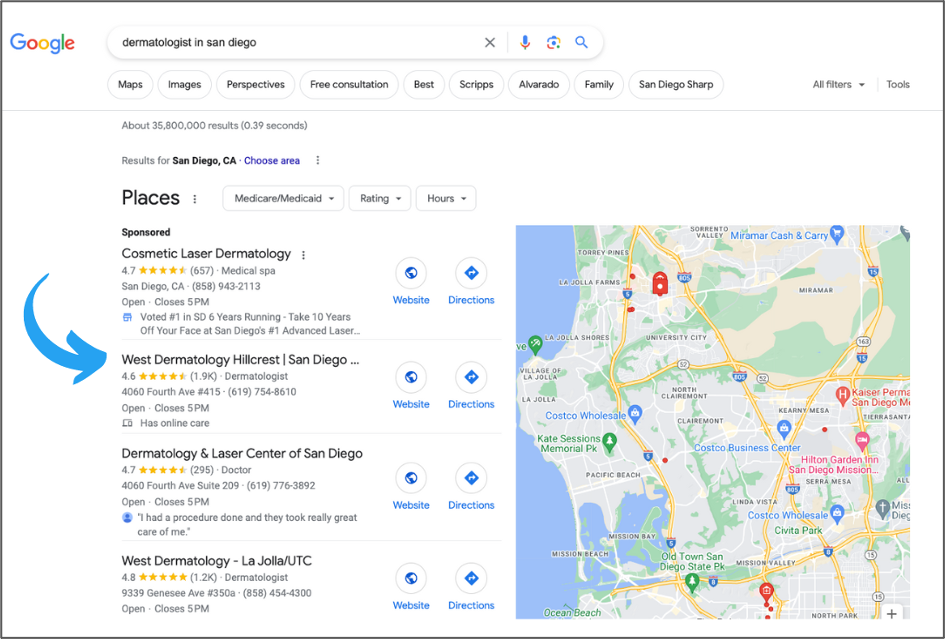
Review and Rating Schema for Healthcare Providers
Schema markup for healthcare elevates the impact of earned reviews and star ratings by allowing these elements to appear directly in SERPs, building trust with prospective patients, and helping differentiate your practice in Places’ results.
The “Review” and “Rating” schema clarify the reviews you’ve earned, making it easier for search engines to understand.
Providers, clinicians, medical staff, and support staff should understand the importance of gathering 5-star ratings and positive reviews for results display. And understand the potential impact a negative review can have on overall ratings. Schema also communicates the number of reviews collected, and often that and the ratings themselves can be a deciding factor in where prospective patients click.
Rich Snippets and Their Benefits for Healthcare Pages
Rich snippets make your search results stand out. These enhanced results allow for faster comprehension of your products, services, and reputation.
Check out these examples of rich snippets for healthcare queries and compare them to regular results. Which one are you more likely to click?
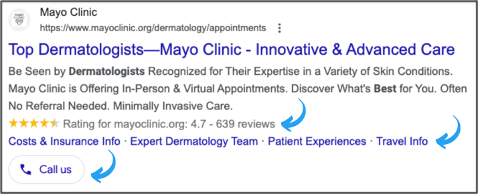

Like most SEO and digital marketing strategies, rich snippets from structured data are not a set-it-and-forget-it tactic. It’s important to regularly measure user engagement and optimize your web page content and accompanying markup for maximum clicks and conversions.
Compliance and Privacy Considerations in Healthcare Markup
While healthcare schema markup offers several advantages, it’s important to be aware of potential issues.
Healthcare organizations must ensure their schema markup implementation aligns with HIPAA regulations. That means careful consideration throughout the entire process, from schema implementation partners to the types of information you disclose and how it is presented.
Generally, schema does not go against any HIPAA data collection criteria. However, if you work with a third-party vendor for schema implementation, ensuring their process involves anonymizing any patient data and refraining from including any PHI in schema markup is crucial.
Getting them to sign a Business Associate Agreement (BAA) is equally important as it safeguards patient confidentiality and lowers the risk of regulatory penalties for your organization.
Prioritizing patient data creates trust and confidence among patients while optimizing their online experience.
Drive More Meaningful Engagement With Your Target Audience
Schema markup for healthcare websites has the potential to achieve rich results (e.g., snippets) in SERPs that captivate high-intent users, driving increased clicks, leads, and conversions.
This enhanced visibility potentially translates into tangible results for your organization: more patients and revenue.
If you’re ready to influence how search engines recognize your organization’s web page content and increase its visibility while ensuring HIPAA compliance, contact Healthcare Success today. Together, we can elevate your healthcare SEO strategy, enhance online visibility, and drive more meaningful engagement with your target audience.
This is the first of two new blogs about schema markup for healthcare. The second will focus on the deeper implications linked data, which can improve how search engines see and interpret your website, ultimately enhancing its visibility and search ranking.
Related Articles:
The Ultimate Guide to Healthcare SEO: 3 Techniques Your Website's Organic Marketing Needs
How to Optimize Content for SEO to Rank Higher
The Evolution of Search & Its Impact on SEO
How Healthcare SEO Has Changed The Past Decade and What’s Ahead
Why SEO is the Vital Ingredient in Healthcare Website Design









